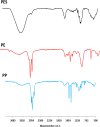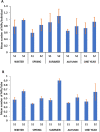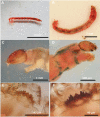Seasonal variations of microplastic in sediment, Chironomus sp. larvae, and chironomid tubes in two wastewater sites in Sohag Governorate, Egypt
- PMID: 38008829
- PMCID: PMC10754750
- DOI: 10.1007/s11356-023-30855-4
Seasonal variations of microplastic in sediment, Chironomus sp. larvae, and chironomid tubes in two wastewater sites in Sohag Governorate, Egypt
Abstract
Microplastic (MP) contamination is an acknowledged global problem that poses a severe risk to aquatic ecosystem biota. Nevertheless, little is known about their prevalence in animal construction. The main objective of our study was to reduce the gap information of seasonal abundance, distribution, composition, and risk assessment of MP contamination. The concentrations of MPs in sediment, Chironomus sp. larvae, and their tubes were found to be higher in site 2 (S2) than in site 1 (S1) during the four seasons of the year. However, MP concentrations ranged from 312 ± 64.7 to 470 ± 70 items/kg dry weight, 0.79 ± 0.16 to 1.1 ± 0.3 particles/individual, and 0.5 ± 0.04 to 0.9 ± 0.04 particles/tube in sediment, Chironomus, and chironomid tubes, respectively. Blue and red polyester fibers are the most dominant MPs which are distributed in sediment, Chironomus, and chironomid tubes. The length of the dominant fiber accumulates in Chironomus, and their tubes are highly varied compared to that of the substrate. Additionally, we found that the mean number of MPs/individual larvae in the fourth instar was significantly higher than that in the second instar. Risk indicators for the environment, polymer risk assessment, and pollution load were estimated, where they were higher in S2 than in S1 correlated to MPs abundance and polymer type. The seasonal fluctuation in MP concentration, characterization, and risk in the two sites could depend on the amount of sewage effluent discharged into the wastewater treatment plants (WWTPs), which was reflected by Chironomus sp. larvae. Therefore, further research should be done to adopt the applicability of Chironomus as MP bioindicators in various freshwater environments throughout the world.
Keywords: Chironomid tube; Chironomus sp.; Microplastic; Sediment; Wastewater.
© 2023. The Author(s).
Conflict of interest statement
The authors declare no competing interests.
Figures










Similar articles
-
Chironomus sp. as a Bioindicator for Assessing Microplastic Contamination and the Heavy Metals Associated with It in the Sediment of Wastewater in Sohag Governorate, Egypt.Water Air Soil Pollut. 2023;234(3):161. doi: 10.1007/s11270-023-06179-x. Epub 2023 Feb 24. Water Air Soil Pollut. 2023. PMID: 36855709 Free PMC article.
-
Interactions between microplastics and Culex sp. larvae in wastewater.Water Environ Res. 2024 Feb;96(2):e11003. doi: 10.1002/wer.11003. Water Environ Res. 2024. PMID: 38385906
-
Seasonal variations and risk assessment of microplastic contamination in agricultural soil and associated macroinvertebrates in Egypt.Sci Rep. 2025 Feb 24;15(1):6590. doi: 10.1038/s41598-025-88715-9. Sci Rep. 2025. PMID: 39994349 Free PMC article.
-
Microplastics in Asian freshwater ecosystems: Current knowledge and perspectives.Sci Total Environ. 2022 Feb 20;808:151989. doi: 10.1016/j.scitotenv.2021.151989. Epub 2021 Dec 6. Sci Total Environ. 2022. PMID: 34883176 Review.
-
Wastewater treatment plants act as essential sources of microplastic formation in aquatic environments: A critical review.Water Res. 2022 Aug 1;221:118825. doi: 10.1016/j.watres.2022.118825. Epub 2022 Jul 5. Water Res. 2022. PMID: 35949074 Review.
References
-
- Akhbarizadeh R, Dobaradaran S, Nabipour I, Tajbakhsh S, Darabi AH, Spitz J. Abundance, composition, and potential intake of MPs in canned fish. Mar Pollut Bull. 2020;160:111633. - PubMed
-
- Akhbarizadeh R, Dobaradaran S, Schmidt TC, Nabipour I, Spitz J. Worldwide bottled water occurrence of emerging contaminants: a review of the recent scientific literature. J Hazard Mater. 2020;392:122271. - PubMed
-
- Akhbarizadeh R, Dobaradaran S, Amouei Torkmahalleh M, Saeedi R, Aibaghi R, Faraji Ghasemi F. Suspended fine particulate matter (PM2.5), MPs (MPs), and polycyclic aromatic hydrocarbons (PAHs) in air: their possible relationships and health implications. Environ Res. 2021;192:110339. - PubMed
-
- Akindele EO, Ehlers SM, Koop JH. First empirical study of freshwater MPs in West Africa using gastropods from Nigeria as bioindicators. Limnologica. 2019;78:125708.
MeSH terms
Substances
LinkOut - more resources
Full Text Sources
Miscellaneous

